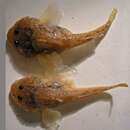Diagnostic Description
(
Inglês
)
fornecido por Fishbase
This species is distinguished from all congeners in the Black Sea basin by having the anal-fin origin in front of the vertical through the second dorsal-fin origin and by the combination of the following non-unique characters: body with three dark blotches; often dark spot on back just in front of second dorsal fin; tubercles relatively small so that tubercles and granules on head not clearly different in size; first semicircle blotch narrow, not extending origin of second dorsal fin; absence of granules on caudal peduncle; lm rows of neuromasts 15-21, commonly 17-18; second dorsal-fin segmented rays commonly 7½ -8½ (Ref. 58669).Description: first dorsal fin with 3 or, more often, 4 spines, second dorsal fin with 6½ -9-½ segmented rays; anal fin with 7½ -9½ segmented rays (Ref. 58669).
- licença
- cc-by-nc
- direitos autorais
- FishBase
Biology
(
Inglês
)
fornecido por Fishbase
Prefers fresh and brackish waters, mostly on river mouths (abundant), lower reaches of rivers and reservoirs and does not enter the sea (Ref. 58669, 59043). Lives on silty sand with mollusc shells; feeding mostly on molluscs and crustaceans. Life span about a year; spawns in May to August; females probably lay eggs in 2-3 portions inside or under a mollusc shell; and adults die soon after spawning (Ref. 59043). Invasive in the large tributaries of the Caspian and Black Sea (Ref. 92840).
- licença
- cc-by-nc
- direitos autorais
- FishBase

